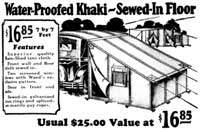Commercial use of the word “camp” declined in the late 1930s, especially when the proprietor’s aim was to cater to business travelers. Older cabin camps were increasingly left to the working class or itinerants, except in resort areas. Their image slid further after a well-publicized magazine article in 1940 labeled the majority of auto camps as havens for fugitives, prostitutes, and drug addicts. [14]
Auto camps are still well represented along highways throughout the Pacific Northwest. A few of them have been documented in county surveys of properties potentially eligible for the National Register of Historic Places, but they continue to disappear due to deterioration and changing uses. Many of the losses can be attributed to the failure of property owners and county officials to recognize auto camps as potentially significant historic resources.
 Camping enthusiasts could find auto tents, like this one, in their Montgomery Ward catalog, 1929
Camping enthusiasts could find auto tents, like this one, in their Montgomery Ward catalog, 1929
Three surveys conducted since 1976 identified eleven camps located in the two southwest Oregon counties as possibly significant historic properties. Five of these are located in Jackson County with the remainder in Josephine County. In contrast to the inns and hotels which preceded them, there has been comparatively little effort expended to preserve significant examples of this type of travelers’ accommodation. The lack of appreciation for how the automobile forever changed the region’s transportation infrastructure during the quarter century before 1940 is one reason. Another difficulty is an inability to identify auto camps and how they evolved from the first free municipal campgrounds in 1915, to the motor hotels (or “motel”) by the end of World War I. The remaining auto camps in local areas will have little chance to avoid eventual obliteration if their importance remains unknown and nothing is done to put them into context with the regional pattern of development.
Some auto camps in southwest Oregon might qualify for listing on the National Register because they meet Criterion A. This is where property is associated with processes that have been significant parts of “broad patterns” of national, state, or local history. They might also qualify under Criterion C, where a property is a good example of a particular kind of architectural style, or if it represents a significant and distinguishable entity whose components may lack individual distinction (such as a group of cabins that form a district). A camp must also meet a seven-way test for integrity of location, design, setting, materials, workmanship, feeling, and association. The tests for integrity are intended to disqualify those properties compromised by unsympathetic alterations.

